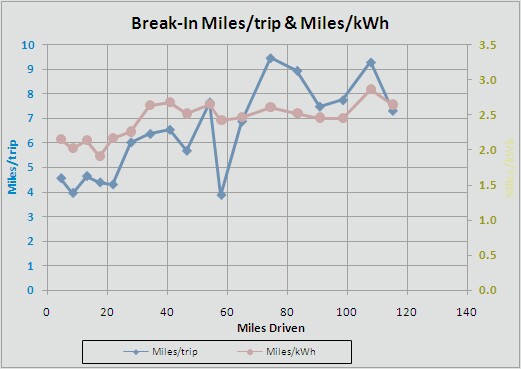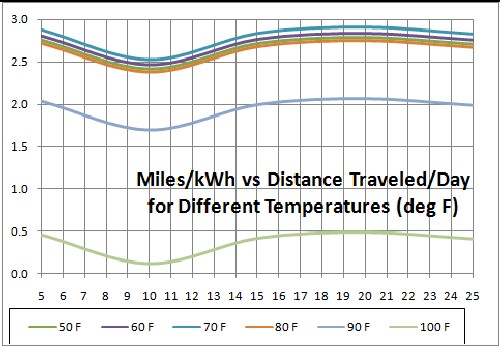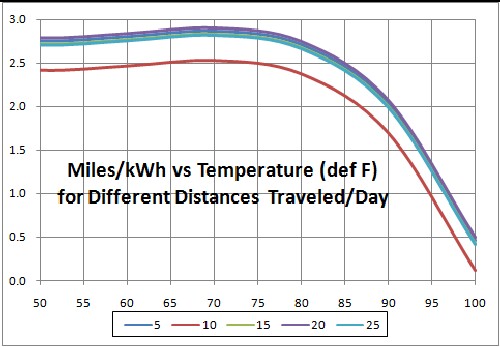bad batteries, blown charger fuse, Woodward large display, new battery set, 84-volts conversion, Guest charger, broken emergency-brake cable, charger-fuse-holder bad, Woodward display with SD card, new radio, bad DC-DC converter, replaced PowerCheqs with BattEq, simple EV circuit, bad charger |
19 January 2008
Still waiting for the Delta-q QuiQ charger to arrive from ZAP after reprogramming.
I am charging the batteries with a 12-volts charger, using the PowerCheqs to distribute the charge to all batteries.
Today, after charging the batteries for many hours with the 12V charger and PowerCheqs, I drove for about 5 miles and the low battery light came on. PakTrakr showed that the battery next to the most positive battery needed recharging. Apparent that battery is bad, although the battery tester did not show that a few weeks ago. The most positive battery also looks weak by the PakTrakr.
|
23 January 2008
Internet dialog with Power Designers about PowerCheqs:
LDR: Can I put a switch on the white wire to use to turn off a PowerCheq. If not, where should I put the switch?
PD: Placing a switch in the white lead will prevent the PowerCheq from equalizing the batteries it will not however stop the quiescent current draw of the power supply. The supply is derived across the violet and yellow leads. Quiescent current is less than 5 mA so in order to remove 1 A-hr from your battery the PowerCheq would needs be connected for 200 hours a bit over 8 days. To completely disable this current draw one woul need to open the white and either the yellow or violet wire.
LDR: I just want to prevent the equalizing as I test the batteries individually. So I will put a switch on the white wires.
Heard from Mark Higley that my charger had been delayed being sent back to me because of paper work. He got it straighten out and it is to be sent back to me tomorrow.
|
25 January 2008
Got the charger back from ZAP yesterday and installed it today. |
27 January 2008
Ran the charger several time, but it never showed that it finished charging. Instead several times it showed the error signal of 3 red flashes which means "Charge timeout caused by battery pack not reaching required voltage. Charger output was reduced due to high temperatures." The solution given by the manual is "Check connections. Operate charger at a lower ambient temperature." Th air temperature was about 45 degrees, the bed was up and the charger did not feel hot. The batteries seem to be fully charged showing, after the PowerCheqs did their equalizing, voltages of 13.2-13.3 volts. |
27 January 2008
Installed 5 switches on the white wires of the 5 PowerCheqs. (Information from Power Design: "Placing a switch in the white lead will prevent the PowerCheq from equalizing the batteries; it will not, however, stop the quiescent current draw of the power supply. The supply is derived across the violet and yellow leads. Quiescent current is less than 5 mA so in order to remove 1 A-hr from your battery the PowerCheq would needs be connected for 200 hours a bit over 8 days. To completely disable this current draw one would need to open the white and either the yellow or violet wire.")
used the 5 switches to turn off the PowerCheqs. Then I drove for 7.1 ZAP miles (6.1 real miles). Before the drive the voltages were 13.0, 13.0, 13.1, 13.0, 13.0, 12.9. 10 minutes after the drive the voltages were 12.8, 12.8, 12.9, 12.8, 12.8, 12.7. So, the batteries appear to be ok. It appears that the battery problem was having the wrong algorithm in the charger. |
27 January 2008
Although the voltages look ok, I still cannot drive 10 miles without the low-battery light coming on. At that point PakTrakr indicates that battery 5 needs charging. When charging the batteries, Pak Trakr shows an error that battery 5 is failing. Apparently battery 5 is bad. |
6 February 2008
Got the Woodward large display for PakTrakr today.
Contacted Harris Batteries about my Discover EV12A-A batteries. I was told to run them down and then run the battery-load tester. I went for about a 10 mile drive with an hour's rest in the middle. Near home the low-battery light showed when Sun Roper was pulling hard up a hill; the Woodward PakTrakr display showed slightly above 11 volts for batteries 1 through 4, about 9 volts for battery 5 and about 10 volts for battery 6. I then load tested the batteries. They all showed about 12.3 volts before I put the load across each battery. At load the voltages of the batteries were about 9.5, 8.5, 9, 8.5, 7 and 7.5. So, apparently batteries 5 & 6 are bad. (The way PakTrakr is connected to the Sun Roper battery pack, battery 1 is the most negative battery and battery 6 is the most positive battery.) |
11 February 2008
Harris Batteries called to tell me that they are sending me two new batteries and will come by later to pick up the two bad ones. Should I charge the two batteries with my 12-volts charger before I put them in Sun Roper? I plan to charge the old set before making the switch. From the layout it appears that I will have to take battery 4 out first in order to take out the bad batteries 5 & 6 (most positive battery).
|
13 February 2008
Sent the current sensor back to PakTrakr to check it out. It checked out ok there. So I now need to send the PakTrakr display to get it checked out.
|
15 February 2008
The Delta-q QuiQ charger did not complete charging last night. The red light blinks 6 times, which means: "Charger Internal Fault. Reset charger (interrupt AC power for 15 seconds). Return to qualified service depot if fault persists." I contacted Mark Higley about the problem; he told me to call DeltaQ at 604-431-8244. I called and left a message.
Tried the QuiQ several times and got the same error.
Then I used a 12-volts charger, and the PowerCheqs to distribute the charge among the 6 batteries, to charge the batteries. (It takes a long time because, although the charger shows 10 amps going into a single battery, the KillAWatt meter only shows about 1.5-2 amps.) |
16 February 2008
This morning I tried the QuiQ charger again and now it always shows the 2-flashes error, which means: "Battery Low Voltage. Check battery size and condition and reset charger (interrupt AC power for 15 seconds)"
In the evening I checked the 25-amps fuse between the charger and the positive terminal of the most positive battery and it was burned out and even melted on one side. I replaced it and the charger worked. |
17 February 2008
The red light on the Battery Life Saver desulfator turns off when the Delta-q QuiQ charger is charging the batteries; the BLS remains warm, so it must still be working.
I sent the following message to Delta-q today:
I have the Delta-q QuiQ charger running algorithm 42 in my ZAP Xebra PK electric pickup.
- Please give me the technical details of the charging cycles for algorithm 42.
- When the QuiQ charger finishes charging and the solid green light shows solid green, does the charger ever come back on if some device is drawing energy from the batteries?
- The 25-amps fuse between the charger and the most positive battery blew yesterday (half way melted). I put another one in and the charger is working again. What could have blown the fuse?
|
19 February 2008
The 20-amps electric breaker switch often has been throwing when I plug in Sun Roper. I had Bell Electric come today to install a new breaker switch, which seems to solve the problem. |
20 February 2008
The two batteries arrived today by UPS from Harris Battery, but one was broken such that the positive pole had sunk about ½” into the case. (See attached pictures). Both batteries are fully charged. Harris Battery is sending another one and UPS is going to come back to check out the damaged one.
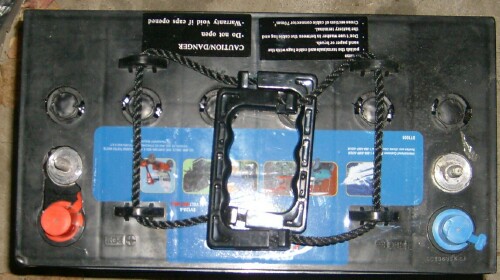
The other new battery started hissing when I charged it, apparently because one corner of it was damaged in transport. |
22 February 2008
For the last several days the big Woodward PakTrakr large display has been flickering often when I drive over a bump. I can cause it to happen by lightly striking the connection between the ES1R and the display. It appears that there is a loose wire connection in either the ES1R or the display connector.
|
25 February 2008
Harris battery called to tell me that they will deliver the two new batteries to me after the middle of March after I return from a vacation. |
26 February 2008
Got the new Woodward PakTrakr large display and installed it:
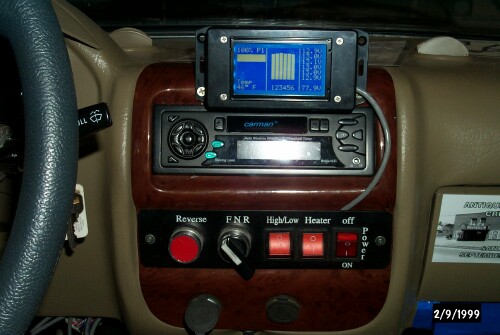

It is wired to turn on/off by the right-hand "power" switch, along with the left-hand power outlet.
It is much easier to keep track of individual battery voltages and system current as one drives using the Woodward PakTrakr display instead of the small Paktrakr display.
|
28 February 2008
I think that battery #2 is going bad, making 3 bad batteries. |
1 March 2008
Got the Woodward PakTrakr display with the screw connectors inside to make it easy to replace the display. I installed it. |
3 March 2008
Harris Battery is going to replace 3 batteries under warranty and I am going to buy 3 more for $544 exchange price each.
After breaking in, I am going to only drive the new set a maximum of 20 miles, instead of 30 that I sometimes did the old set. And I am going to stay away from the steep hills that I could not resist before.
|
13 March 2008
Left Sun Roper fully charged on the charger with the PowerCheqs on and the PakTrakr on for a week. When I got back it took about 3.5 kW to charge it back up. I did not think that the PowerCheqs and Paktrakr would use that much energy. |
14 March 2008
I install 5 switches on the yellow wires of the PowerCheqs so that I can, with the 5 switches on the white wires, turn them completely off when desired.
Install two EMI data core suppression clamps from Jameco, according to the recommendation of Norm Woodward to try to suppress the interference with PakTrakr data. Norm: "
... snap one of these items onto the cable coming from the current sensor about 4 inches from where it plugs into the ES1R, and another one on the cable of the ES1R itself, about half way between where it plugs into the PakTrakr and the serial connector." I still got interference when accelerating. I will try putting others at other locations. |
17 March 2008
Harris Battery delivered 6 new Discover EV12A-A batteries today; 3 for warranty and 3 to buy. I paid $532.60 for each of the 3 batteries plus $41.22 fuel surcharge for delivery and $95.87 VA sales tax, for a total of $1734.89.
It took me about 20 minutes to take the old batteries out of Sun Roper and about 75 minutes to put in the new ones, including installing PakTrakr and the 5 PowerCheqs. Here is a picture I took when there were no batteries in SR:

The two outer batteries have to put in before the three inner batteries are put in.
I will now carefully break in the battery set and then only drive 15 miles per charge most of the time, to try to make these batteries last longer than the old ones did (about 3000 miles). Apparently I stressed the old batteries way too much by driving nearly 30 miles per charge many times and driving up steep hills. See below for a graph of the break-in miles/trip and miles/kWh during breakin for the new battery set. |
18 March 2008
After fully charging the new batteries last night, I did the first 5-miles break-in run this morning. Then I fully charged them again and did the 2nd 5-miles break-in run in the afternoon. I will do five 5-miles runs, then two 7-miles runs and then two 10 miles runs and then try 15 miles. I plan to not exceed 15 miles between charges most of the time and to stay away from steep hills.
|
20 March 2008
Discovered today that the horn is not working. It made a clicking sound. I purchased a new, almost identical horn at Advance Auto, a "freeway blaster". |
28 March 2008
The 25-amps fuse on the wire from the Delta Qui/Q charger to the positive pole of the battery blew again today, as one did on 16 February. This is discussed on the xebra-ev group on Yahoo.com.
I ordered the 84-Volts upgrade and an extra Discover EV12A-A battery today. |
29 March 2008
To prepare for the extra battery for the 84-Volts upgrade, I cut out the bar that holds the spare tire:
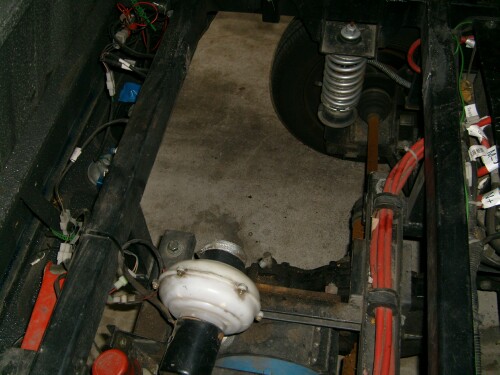
|
29 March 2008
Did a rough calculation of how much improvement in acceleration the 84-volts upgrade will give Sun Roper, as follows:
Weight of Sun Roper before upgrade: 1820+120 (heavier batteries than stock)+100 (bed liner top & bottom & solar panel & frame) = 2040 lbs.
Weight of Sun Roper after upgrade: 2040 + 110 (extra battery, battery case & charger) = 2150.
acceleration = power/momentum = (VI)/(mv), where V=voltage, I=current, m=mass & v=vehicle speed.
Thus, (new accel)/(old accel) = (0.03907)/(0.03529)=1.107
So, for a constant current into the motor and a constant speed of the vehicle, the improvement in acceleration is about 11%.
Of course, the ratio of ranges should be about 7/6 = 1.167 or a 17% increase. It might be slightly larger than that, because of the lower resistance heat loss in the wires due to lower currents at a given speed. |
2 April 2008
The right emergency cable broke yesterday. So, I took Sun Roper to South Main Auto to have the cable replaced, have the left axle replacement (which I got from ZAP several months ago) done, have the front shock bolt replaced with Woodward's zerked bolt, have a sqeak fixed and have the yearly Virginia state inspection done. |
9 April 2008
The battery box and charger for the 7th battery came in from Grants Pass EV yesterday. I installed the battery box:
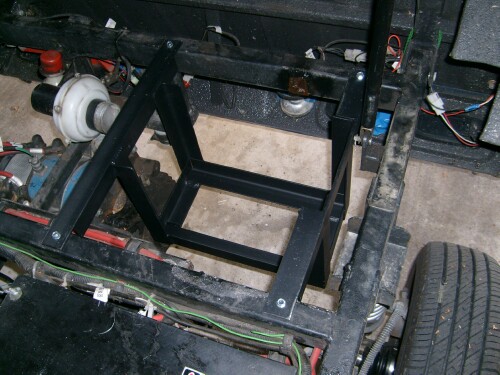
Now I need to install the charger.
Then the battery came in later in the day. Here is it installed:
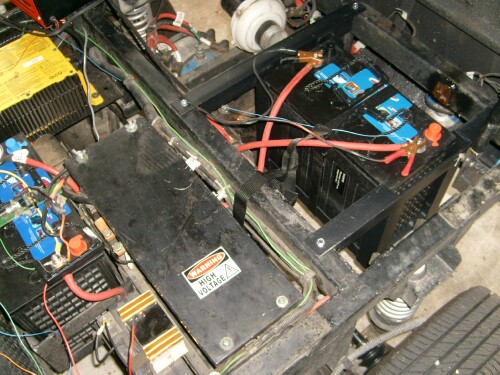
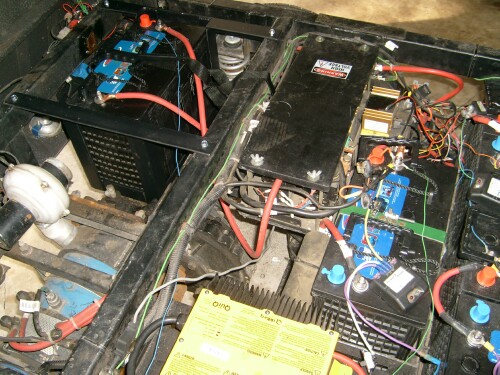
Took it for a 5-mile test drive and it really makes a difference! |
12 April 2008
Patched the Guest charger for the 7th battery in front of the connector leading into the Delta Qui/Q charger, so that both chargers will run when external power is attached to Sun Roper:
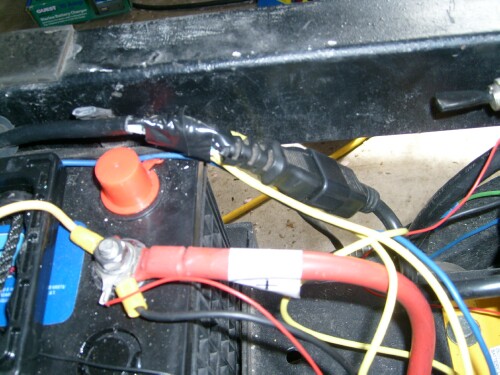
The Guest charger location is beside the Qui/Q charger attached to the rail by 14.25" plastic ties:
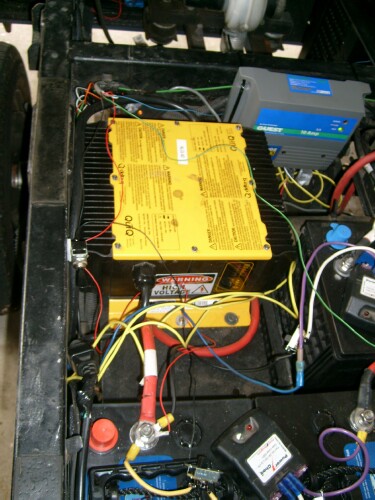
While doing this wiring I decided to look inside the Delta Qui/Q charger:
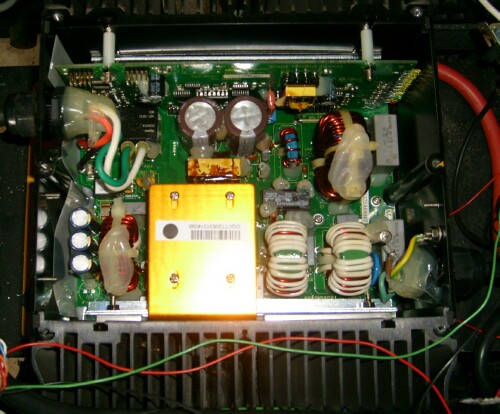
|
15 April 2008
Sun Roper is an entirely different vehicle with the extra battery. I can now drive SR on the US460 bypass around Blacksburg to the two north exits of Christiansburg at speeds between 35 mph & 45 mph. |
19 April 2008
I am having the following problem with Sun Roper (a PK):
Sometimes it will not start in both forward and reverse. If I fiddle with turning the system on and off and taking it out of drive and back into forward and reverse, it always then starts after several tries. This often happens when I first drive the car after a full charge overnight, but it sometimes happens in other circumstances.
Twice I have traveled across moderate bumps at moderate speeds and it stopped. Again, when I fiddled with turning the system on and off and taking it out of drive and back into forward and reverse, it would then start. One of those times was when I was pulling out of a parking lot onto a main road; fortunately, with the help of two young men, we were able to push it backward into the parking lot before much traffic came along. Then I was able to get it going again by fiddling.
A diagnosis would be appreciated. (I submitted this to the xebra-ev group on Yahoo.com.)
Found a good web page explaining how contactors work. |
21 April 2008
New emergency-brake cables were installed today at South Main Auto. The cables cost $50 and it cost $224 to install them. Here is what the broken cable looked like:

|
25 April 2008
Am doing a study of how miles/kWh varies with distance driven per day and with temperature. Watch this web page for the results as the data are recorded.
I think the problem with stopping was due to the broken e-brake cable on the left. It has not occurred since I got the cables replaced. |
27 April 2008
Sun Roper hauled two heavy loads to help move Valley Interfaith Child Care Center to its new location at Good Shepherd Church of the Brethren. |
28 April 2008
Still having trouble of not SR not moving unless I fiddle with the controls for a while. |
12 May 2008
I, like others, have had the 25-amps charger fuse blow (twice) in the last year. Also, often one side of the fuse melts and/or the tab on that side gets eaten away.Yesterday when I tried to drive Sun Roper, the low-battery light flashed on and off and there were clicking sounds. I opened the bed and plugged in the charger and sparks started flying on that end of the fuse holder. That tab on the fuse was badly eaten up. I cleaned up that side of the fuse holder and put in a new fuse. Then the vehicle ran fine, after hesitating getting started, as is sometimes the case.
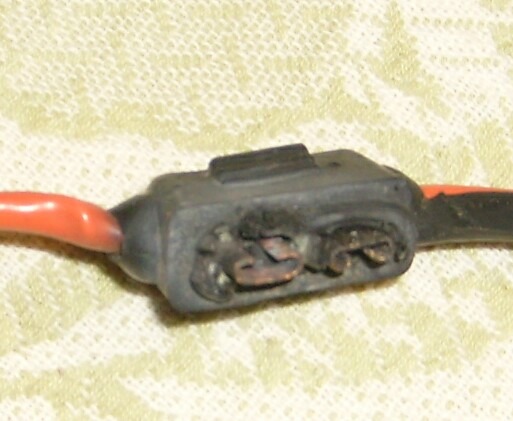
Today I went to Advance Auto and bought the fuse holder HHM to replace the charger fuse holder:
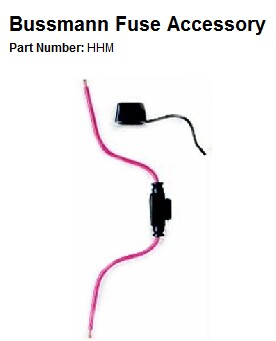
Here is the location of the charger fuse holder:
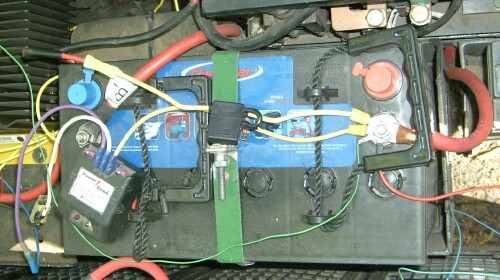
Drove about 15 miles after putting in the new fuse holder and had no problem. Maybe I have solved the problem I have been having for a long time! |
13 May 2008
Removed the charger fuse from its fuse holder and the system would not turn on! I asked other users on yahoo/ev-xebra if they have the same problem. |
20 May 2008
Got the SD logger version upgrade of the Woodward PakTrakr display. It is great!! Here is a log of a short trip of three stops plus charging afterwards:
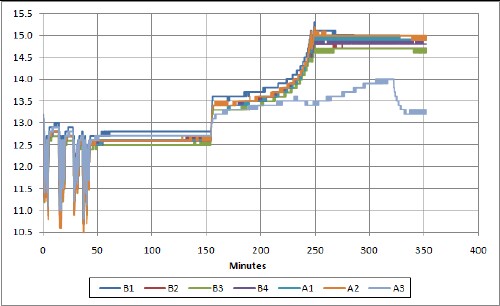
Note the different charging profile for the 7th battery (A3 on chart) on its separate charger. Apparently the Delta QuiQ charger for the first 6 batteries is still in its final phase of charging. |
29 May 2008
Joseph Gottlieb told me that his PK's solar panel has cracked in places. Today I wedged a 2x4 board in the middle of it; the two ends on opposite sides had to be notched to get it in.
Got the latest PakTrakr large display from Norm Woodward today. It shows both current and power. |
3 June 2008
Had Scotty's of Blacksburg replace the PK radio with the Kenwood KDC-238. Now I get excellent FM reception. |
7 June 2008
Bought the inflatable Handirack for my 2005 Prius, but it also works for Xebras and other autos:
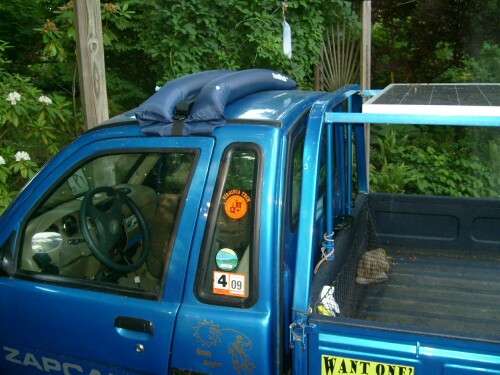 |
14 June 2008
Apparently the DC-DC converter quit working today. I did some diagnostics and will do more tomorrow. |
14 June 2008
Finally was able to unplug the gray plug for the DC-DC converter by pinching on the tab and pulling hard with pliers. Then I checked the voltages: The small black plug brings the 72 volts in and it was ok. The large gray plug takes the 12 volts out and it was ok. So my problem is not the DC-DC converter, at least at the present time. (See below.) (The conversion takes place when the key is turned on.) Since a relay was buzzing at one point, I decided to look into one of them being bad. There are two 72-volts relays: JD4 and JD8. In interchanged the two and the vehicle ran! So, apparently one of them is bad, I thought. But then I interchanged them back to the original and the vehicle ran! (I found that the vehicle will run when JD8 is not in place.) My present conclusion is that the hot weather affected the DC-DC converter and, now with cooler weather, it is ok. I am going to get a spare DC-DC converter.
|
16 June 2008
Installed the Woodward large display for PakTrakr below the dash to make it easier to read in sunlight and to not get so hot from heat from the Sun.
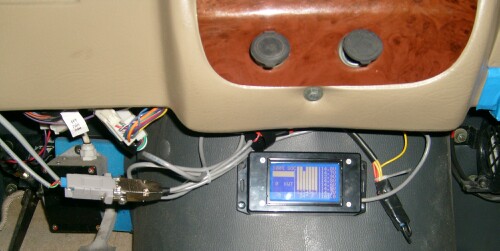
|
17 June 2008
Ordered a DC-DC converter ($168) and a contactor ($79.95) from ZAP. |
24 June 2008
Took out the PowerCheqs and installed the BattEq for 6 batteries:

|
24 June 2008
Got the new DC-DC converter and a contactor from ZAP. The 12-volt plug on the converter is different than the plug on the old converter. E-mailed ZAP about a possible bridge between the two plug types. Here are what the different plugs look like (left = new; right = old):
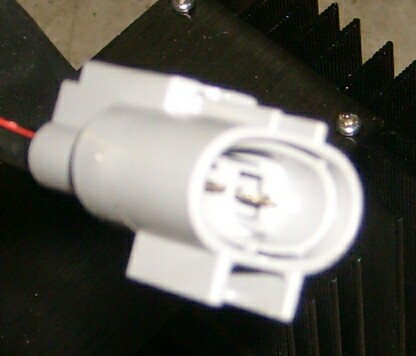 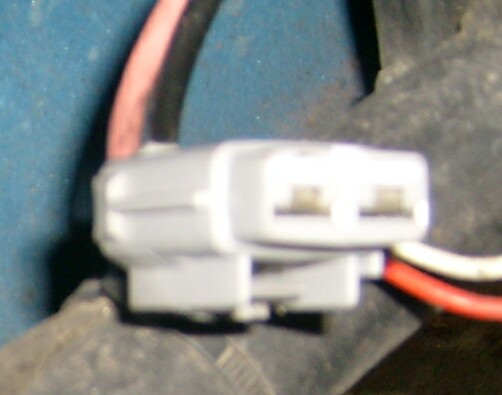
|
29 June 2008
Ordered a heat gun for doing heat-shrink connections. |
1 July 2008
Here is a simplified circuit for an electric vehicle:
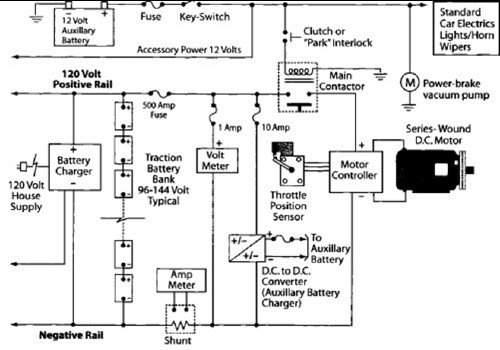
It is easier to pay attention to the main components in this diagram than it is in the complete ZAP Xebra circuit diagram . |
1 July 2008
Installed the new DC-DC converter:
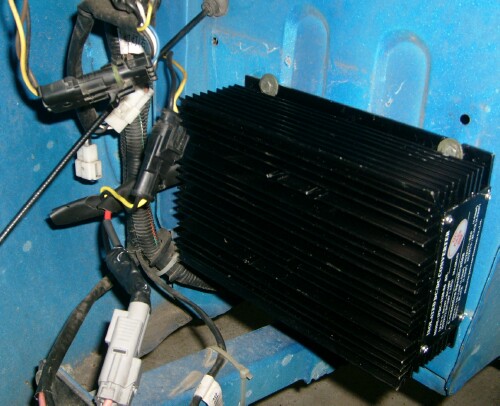

As can be seen in the first picture above three new holes had to be drilled. As indicated above, the 12-volt plugs had to be exchanged between the old and new converters.
I believe that the trouble I had with starting Sun Roper's system when it was very hot was because the vents of the old converter had been sealed to keep water out, causing it to get too hot and shorting out the 12-volts battery. |
17 July 2008
The Delta QuiQ charger quit working. It blinks the yellow light at the lowest-current light. I contacted Delta-q.com about getting it fixed or trading it for an 84V one. |
18 July 2008
Bought a Schumacher SE-40MAP 10-amp Fast Charger battery charger, so that I can hook two 12-volts battery chargers to batteries 2 & 5 to use with the BattEq to charge all 6 batteries that the QuiQ charged until I get the QuiQ fixed or traded. |
18 July 2008
Sent Delta-q QuiQ charger to ZAP for repair. |
29 July 2008
ZAP called to tell that the charger is under warranty (2 years), so they will send me a new one within a week or so. They offered to loan me one for Steppin' Out, but I declined in order to save energy. |
1-2 August 2008
Displayed Sun Roper at Steppin' Out. Many people stopped by to talk, |
9 August 2008
The 7th battery that I bought in April 2008 is dying. After a 15-miles drive it was showing 8.5-9 volts while the other 6 batteries were showing 11.5-12 volts. I sent an e-mail to Harris Battery asking for a warranty replacement. |
21 August 2008
The new Delta QuiQ charger came today, but with lugs to connect to the battery instead of the Anderson connector:
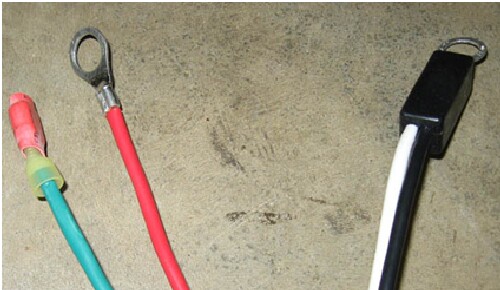
Also, it has algorithm 43 instead of algorithm 42. After e-mail, Michael Rickard of ZAP told me that 43 is now the preferred algorithm for the Discover EV12A-A batteries that Sun Roper has. |
21 August 2008
Installed the new Delta QuiQ charger that has algorithm 43. When I hooked the green wire to the thermistor wire, I heard a pop, but cannot find anything burned out. I wonder if the thermistor got fried. |
22 August 2008
Mark Higley sent me the link to a document that tells how to change the algorithm without using a programmer. On p.3 it indicates that the correct algorithm for the Discover EV12A-A batteries is #5. It says that algorithm 43 is for Discover 200-400 Ah AGM batteries; but the EV12A-A are 138 Ah batteries. Do I need to use the procedure given in the document to change the algorithm to #5, or does that document give old information that is not correct now? I am worried that algorithm #43 is overcharging the SR Discover EV12A-A batteries, and that I should change to algorithm #5. Changed the algorithm back to #42 until I am convinced to do otherwise, because the document states that #42 is for 75-150-Ah batteries and #43 is for 200-400-Ah batteries. Installed a 25-amp switch on the red wire from the charger to the positive pole of the most positive battery to make it easy to change algorithms among the ten resident algorithms.
Got a document from Delta that seems to make it clear that #42 is the one to use for SR's batteries:
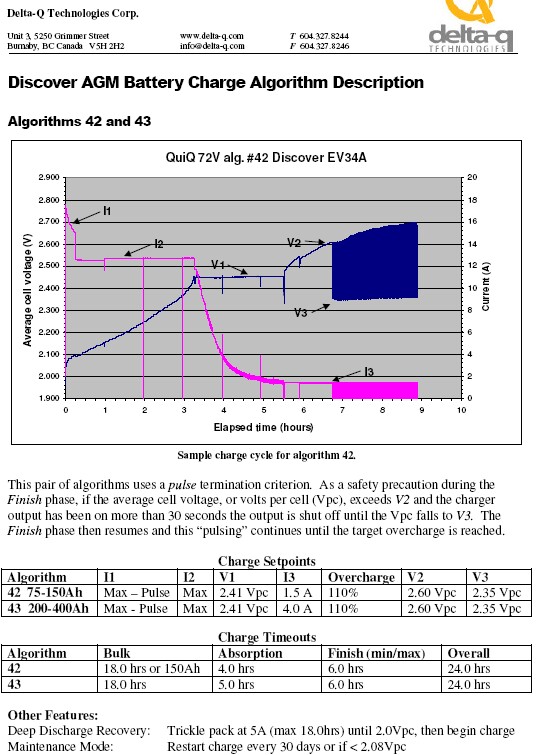
|
25 August 2008
Ordered a 200-amp ammeter and a shunt for it from allelectronics.com.
Harris Battery said that it will send me a new battery to replace the 7th Discover EV12A-A battery that is going bad. I am considering buying a Trojan T1275 wet battery to try out as the 7th battery. It fits into the battery box and can be charged by the Guest charger. |
3 September 2008
Harris Battery sent a truck here yesterday with the battery, but our telepone was not working, so a message was left that I got too late before the truck headed back this morning. I drove 75 miles and back to meet the truck on I81 to trade batteries. I started breaking the battery in with two 2-3 mile trips today. |
4 September 2008
Got a 200-amps ammeter and shunt, so that I can have an good view of the current as I drive. Installed next to the windshield at the extreme left. |
5 September 2008
Finished conditioning the new battery with runs of 2, 3, 4, 5 and 7 miles. |
9 September 2008
Interchanged battery 1 (most negative battey) with battery 6 (most positive battery), since the PakTrakr indicates that 1 was the most powerful battery and 6 was the least powerful battery. (This was also the case with SR's first set of batteries.) I wanted to see if interchanging them has any effect with regard to their power. Both the old set of batteries showed and the new set of batteries in Sun Roper show the most-negative battery (mnb) being stronger than the most-positive battery (mpb) at the end of a long drive. (This is in regard to the first 6 batteries; I have a 7th battery that is on a different charger.)
After charging I noticed that the mnb, which used to be the mpb showed a higher voltage than the mpb, which used to be the mnb, after sitting for a few hours. After driving about 8 miles the mnb ended up with a higher voltage.
So the phenomenon appears to be dependent on the battery position. There are three possibilities for the cause:
- The PakTrakr is reading incorrect voltages dependent on the battery position. I need to check this with an independent voltmeter.
- The charger is causing the mnb to be charged more than the mpb.
- Running the vehicle is causing the mpb to deplete faster than the mnb.
I think it is 2. Does this partial theory hold water?: All of the electrons that are fed by the charger into the 6 batteries cause ions to pass through the most negative battery. The mpb has only its own ions passing through it. Somehow this causes the mnb to be charged more than the mpb.
A similar argument could be made for possibility 3, but the fact that I saw a higher voltage for the mnb a few hours after charging leds me to suspect it is possibility 2.
I am trying another experiment: In addition to charging the 6 batteries with the 72-volts charger, I am also charging the mpb with a 12-volts charger. It will be interesting to see if the mpb will be as strong as the mnb after charging and sitting for a few hours and after driving. |
10 September 2008
Charging the mpb with a separate 12-volts charger while charging the whole set of 6 batteries with the Delta QuiQ charger (Discover EV12A-A batteries) did cause the mpb to end up with a high voltage. However, after driving, its voltage was down to that of the 4 middle batteries.
I conclude that the mnb is favored by the 72-volts charger and by running the vehicle.
I wired the mpb to external leads on a switch so that I can easily hook up a 12-volts charger to it when I charge the vehicle. |
11 November 2008
Sometimes I have to try several times to get the forward contactor to work. Perhaps I need to replace the reverse contactor that has the broken bakelite piece. I have the replacement.
I changed the Delta-QuiQ-charger algorithm from 42 to 43, which is the algorithm recommended by ZAP for the Discover EV12A-A batteries. It overcharges them, I guess to make sure that all are fully charged.
The switch at the grid-power input does not trip sometimes. I guess I need a new one. It looks easy to take it out. Mark Higley told me to just leave it on and unplug-plug to turn the charger on and off. The new Xebra's do not have that switch.
Three of my new set of Discover batteries are dying gradually. Harris Battery wants to pro-rate them at $435 each plus tax and a surcharge. I told them that I am not going to put any more money in Discover batteries.
When they die I hope to rustle up enough funds to put FeP-Li-Ion batteries in. |
~25 November 2008
Michael Ogburn of Aspen Electric in Colorado came with his father, John Ogburn, to install a windshield washer. |
18 November 2008
There was snow on the window this morning, so I turned on the windshield wiper to scrape it off. The wiper was frozen to the window, so the wiper arm broke near the base. I ordered another one from ZAP. |
5 December 2008
Drove Mayor Ron Rordam in the Blacksburg Christmas Parade at 7 PM in mid-20°F weather. There was much stopping and starting over about a 2-mile route. At the finish the three bad batteries were down to zero. So, drove to the YMCA Center to charge up for an hour while I had some food and hot drinks at Abby's Restaurant across the street. The PakTrakr SOC showed 0% before charging and 60% after charging. It made the 4 miles home OK. |
5 December 2008
Contacted Joseph Gottlieb of Electra-City Motors in Escondido CA about installing LiFePO4 batteries in Sun Roper. May get them in February or March. |
























